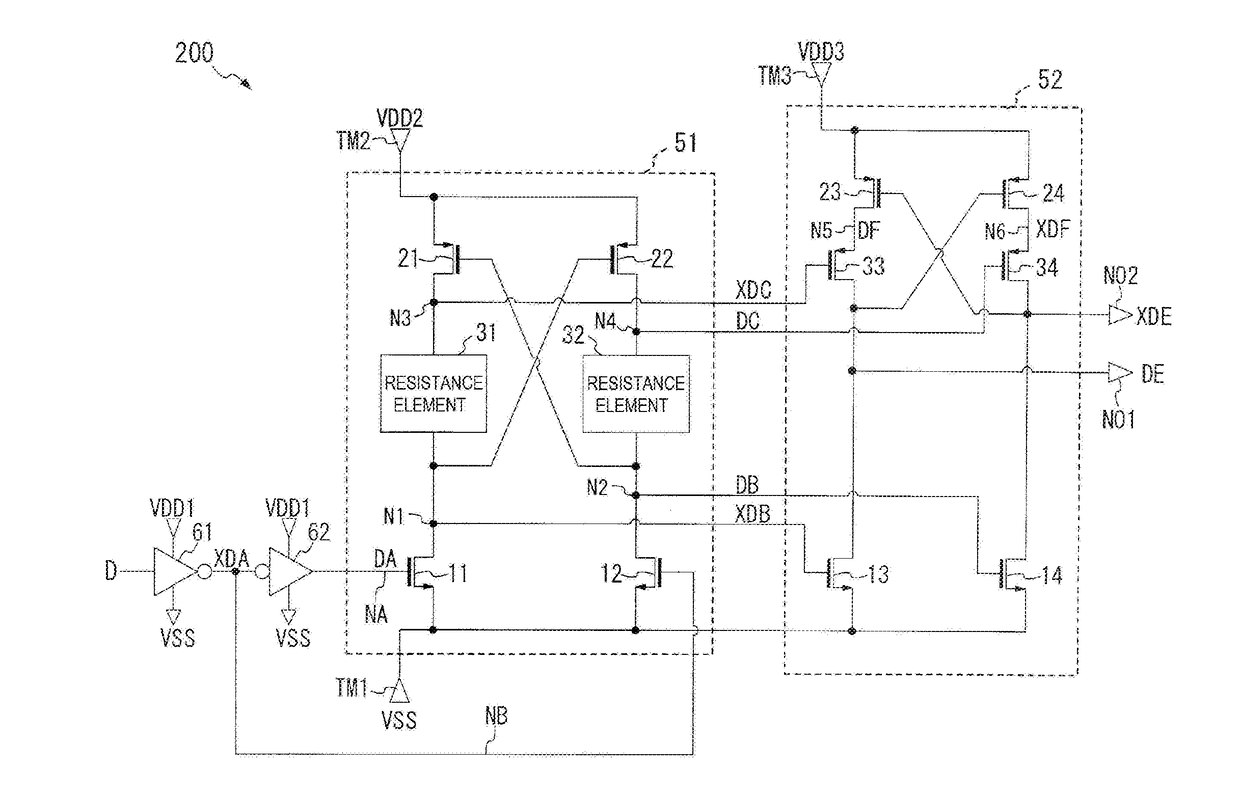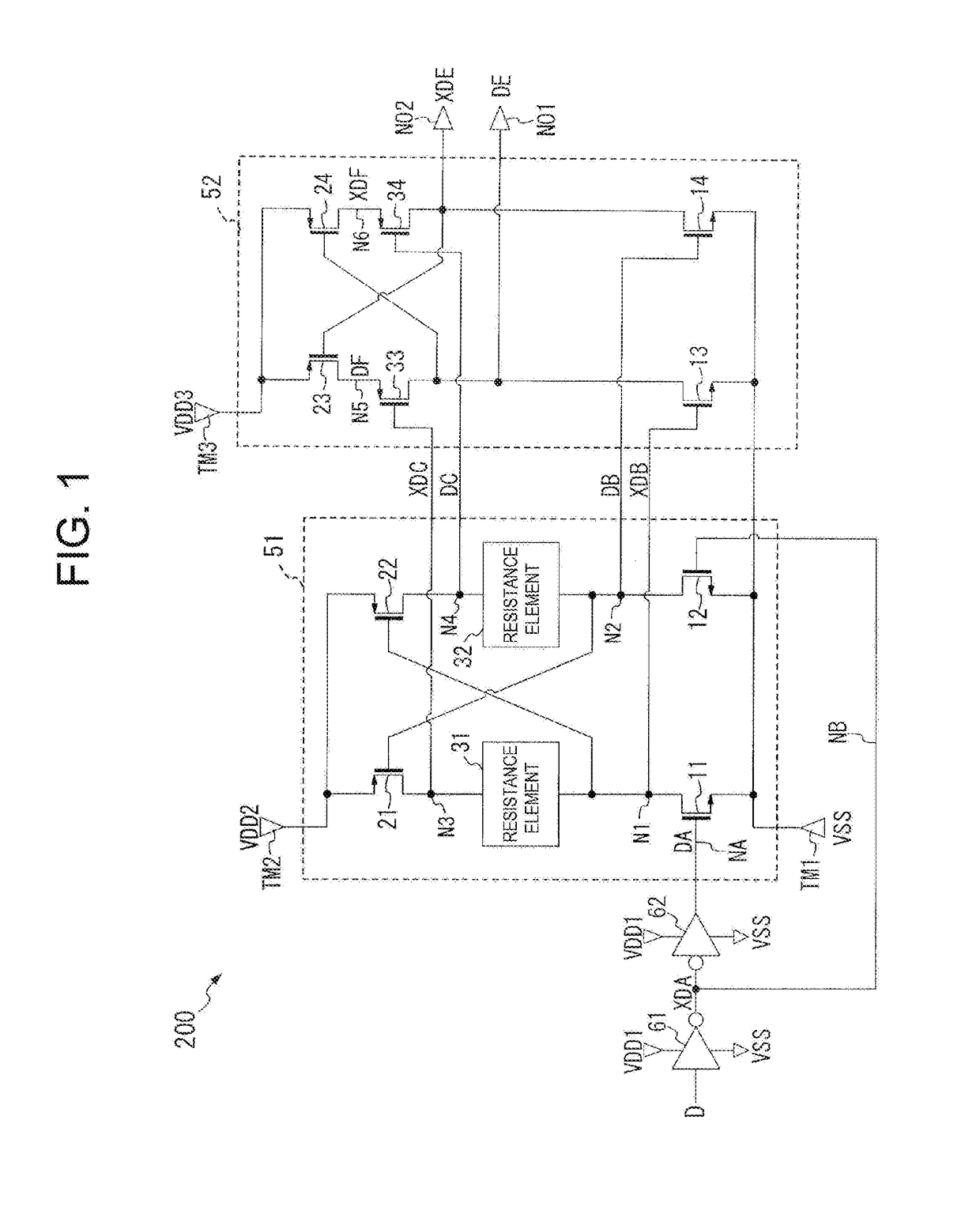Level shift circuit and display driver
a level shift circuit and display driver technology, applied in logic circuits, pulse techniques, instruments, etc., can solve the problems of level shift circuit not working properly in some cases, level shift circuit not working properly, significant increase in circuit amount, etc., to reduce the area occupied by level shift circuit, reduce the effect of current driving capability and increase the operation speed of level shift circui
- Summary
- Abstract
- Description
- Claims
- Application Information
AI Technical Summary
Benefits of technology
Problems solved by technology
Method used
Image
Examples
embodiment 1
[0045]FIG. 2 is a circuit diagram showing the internal configuration of the level shift circuit 200 of Embodiment 1 of the present invention. The level shift circuit 200 of FIG. 2 is the same as that shown in FIG. 1 except that a P-channel MOS transistor 311 that is diode-connected in which the drain and gate terminals are connected to each other is used in place of the resistance element 31 shown in FIG. 1, and a P-channel MOS transistor 321 that is diode-connected in which the drain and gate terminals are connected to each other is used in place of the resistance element 32. The voltage polarity of each of the low power supply potential VDD1, medium power supply potential VDD2, and high power supply potential VDD3 with respect to the reference power supply potential VSS is positive, and the levels of the respective power supply potentials have the same relationship as that of FIG. 1.
[0046]In the transistor 311, the gate and drain terminals are connected to the node N1, and the sou...
embodiment 2
[0066]FIG. 4 is a circuit diagram showing the internal configuration of the level shift circuit 200 of Embodiment 2 of the present invention.
[0067]In the level shift circuit 200 of FIG. 4, an N-channel MOS transistor 312 is used for the resistance element 31 in place of the P-channel MOS transistor 311, and an N-channel MOS transistor 322 is used for the resistance element 32 in place of the P-channel MOS transistor 321. Other configurations are the same as those of FIG. 2. The relationships of the power supply potentials are the same as those of FIG. 1.
[0068]In the transistor 312, the gate and drain terminals are connected to the node N3, and the source terminal is connected to the node N1. In the transistor 322, the gate and drain terminals are connected to the node N4, and the source terminal is connected to the node N2.
[0069]The transistor 312 is configured such that the potential difference between the nodes N1 and N3 when the operation current flows is equal to or greater than...
embodiment 3
[0071]FIG. 5 is a circuit diagram showing the internal configuration of the level shift circuit 200 of Embodiment 3 of the present invention. In the level shift circuit 200 of FIG. 5, a diode 313 is used for the resistance element 31 in place of the MOS transistors (311,312) and a diode 323 is used for the resistance element 32 in place of the transistors (321, 322). Other configurations are the same as those of FIG. 2.
[0072]In the diode 313, the anode is connected to the node N3 and the cathode is connected to the node N1. In the diode 323, the anode is connected to the node N4 and the cathode is connected to the node N2.
[0073]The diode 313 is configured such that the potential difference between the nodes N1 and N3 when the operation current flows is equal to or greater than the absolute value of the threshold voltage of the P-channel transistor 22, and that the potential difference between the nodes N1 and N3 when the current is shut off is smaller than the absolute value of the ...
PUM
 Login to View More
Login to View More Abstract
Description
Claims
Application Information
 Login to View More
Login to View More - R&D
- Intellectual Property
- Life Sciences
- Materials
- Tech Scout
- Unparalleled Data Quality
- Higher Quality Content
- 60% Fewer Hallucinations
Browse by: Latest US Patents, China's latest patents, Technical Efficacy Thesaurus, Application Domain, Technology Topic, Popular Technical Reports.
© 2025 PatSnap. All rights reserved.Legal|Privacy policy|Modern Slavery Act Transparency Statement|Sitemap|About US| Contact US: help@patsnap.com



